Friday 14 June
Packing up and reorganising our ‘stuff’ took up
some of a hot and sticky morning – and I’m still very impressed with our use of
packing cubes, bought at Briscoes ‘sale’ price a few days before we left
home.
Things are much more easily found
and the bags look really tidy. Pete on
the other hand was doing the outside tidying and mowing the lawns again so he
was happy; hot weather and a couple of overnight showers make the grass grow
like mad. Justyna made another of her
delicious lunches, this time vegetable soup and spaghetti bolognese. We were able to give Patryk a big hug goodbye
when Andy took us to the airport but Ellie was at her grandparents’ place after
kindy, but we’ll see them in Croatia in two weeks. And there was the power station still smoking
beside the expressway as we left.
Our flight from Krakow to Naples was delayed by 30
minutes, then a really long wait for the bags, and we were met by Massimo from
the hotel – taxi price and it meant we didn’t have to find our way to a fairly
anonymous Domus Deorum which is a B&B hotel near the railway
station https://domus-deorum-deluxe.hotel-naples.com/en/#photo.
Owner Angela couldn’t have been more welcoming, we
were given a choice of prosecco or red wine (of course it had to be bubbles for
the start of the Italian adventure), there were chocolates waiting in our
small, but very comfortable, room.
What’s not to like?
Saturday 15 June
And then there was breakfast…. the photos pretty
much say it all, and we tried hard but couldn’t eat everything.
This morning’s destination was the Archeological
Museum which houses collections of items taken from Pompeii and Herculaneum but
first we had to negotiate the train station.
Went to the ticket office:
- Can we get a Metro ticket please?
- No, tobacconist
- Can we get a ticket for Ercolano (Herculaneum) for this afternoon?
- No, downstairs
- Can we get a ticket for Sorrento tomorrow?
- Yes, here (we decided to do that tomorrow), so having taken a number, lined up for a short while until it was our turn, we found that not all tickets are sold in a ticket office.
So we found the tobacconist, got the Metro ticket
followed the signs to Line 2 then they disappeared so getting to the correct
platform took a while and it’s a huge station.
At the other end we had a bit of a walk in the heat, 30+ degrees at 11am
and very humid, and found the museum by which time I was pretty much over
it.
There were no English maps (being
reprinted), the only guide being available by QR code scanner – and even though
I connected to the museum internet the scanner didn’t work. So we went into it a bit blind.
Downstairs is full of gallery after gallery of
statues which lose their appeal after a while though I did rather like Emperor
Vespasian who seemed to have a ‘What on earth are they doing now?’ look on his
face (I remember him from the ‘Falco’ series of books by Lindsey Davies, Falco
is a Roman detective, a good read too), and another fellow who just looked
wistful, so they definitely weren’t ‘stony faced’. There were two statues made of really ugly
splodgy brown and white marble, yuck.
Upstairs we found more statues – and I couldn’t
resist ‘Pan and the Goat’ but took it from a fairly delicate angle so make of
it what you will. The view from the
windows down to a cool-looking garden doesn’t show the heat inside the building
and out but it was good to stand in a bit of a breeze as we went around. The galleries here have smaller treasures
unearthed over the years as well as frescoes removed intact from the walls of
houses in both towns, and how they did that 200 years ago without today’s tools
is a miracle.
You could see that they
weren’t just flat paint either, some had raised figures or patterns on the
plaster. My favourite (and one of
Pompeii’s iconic frescoes) is that of the baker Terentius Neo and his wife; it’s
amazing that they could be positively identified for a start, and you can see
they are ‘people of means, cultured and fashionable’ according to the blurb,
and ‘their facial features … betray their provincial origin (they were probably
from Samnium), this clashes somewhat with the cultural tone that their gestures
and attributes establish’. Snobby
writer. I found today’s cat which is about
3cm wide, a beautifully carved lion made from an agate cameo; and loved the
blue and yellow multi-coloured bowl.
So much to see and my brain was majorly fried by
the time we left at 12.45. We ended up
on different Metro line but got to the main station eventually, managed to buy
tickets to Ercolano on a local train.
You could see the humidity in the air, it was so hot. We could see Vesuvius out the windows.
Pete was offered a seat a couple of times so
he may have been looking his almost-65 years? And musicians got on after a
couple of stops so we were serenaded (Funiculi Funicu-laaaaaa on a piano
accordion) for a while before they passed through with a hat looking for donations. BUT
then we overshot the station by overthinking it so ended up getting off and
taking a taxi back to the Herculaneum ticket office to pick up our two-hour
tour of the ruins, guided by an archaeologist.
The taxi driver told us ‘my name is Enzo, like Enzo Ferrari, I will get
you to Ercolano quickly’.
This tour was one of the best we’ve done anywhere,
Dr Luciano loved his work, was keen to share it with our small group of four (a
young Portuguese ophthalmologist and her German partner), kept apologising for
his poor English (it was fine) and then we’d hear ‘Come this way, there is a
special surprise’ and there would be a lovely fresco in the next building, or a
2000-year-old mosaic that we could walk on just as if it was a piece of
ordinary concrete.
Its hard to believe
the floors are not covered but Luciano said the glass breaks or gets
condensation and it just doesn’t work. They
know a lot about the scope and immediate effects of the eruption because a man
called Pliny the younger was able to document what he saw at the time.
The women’s
bath house intrigued me, four intact rooms and they didn’t have a cold bath
because it was said to affect fertility (though other towns had cold baths for women). The roof of the ‘gossip room’ was corrugated
so condensation wouldn’t drop on people, and it had a perfectly intact floor
with dolphins and other fishy creatures.
The next room had a mosaic with squares of black and white showing a
checkerboard, urn, spoon, and a swastika-like emblem. We could see where the heating system had
been too. And the wine shop had shaped shelves for the amphora, but a bit bigger than our similar-shaped wine storage these days.
About ten years ago David Packard, of Hewlett
Packard, bankrolled some of the diggings and a new footbridge to get across to
the site so there has been a lot done thanks to him. We had been to Pompeii 13 years ago and it’s
a huge site; Herculaneum (named after Hercules, who is depicted in an
impressive intact fresco with his red lion skin) is small and easy to
navigate. It was a wealthy town with a
lot of fine marble from all around Italy used in the houses, from benchtops in
the cafes to specks of white marble ‘cats eyes’ in paths which would reflect in
the moonlight.
Pompeii’s streets have
stepping stones to get across the raw sewage running down the streets;
Herculaneum had its own sewer system and water supply to the houses, it was on
a natural slope so easy to get water to and drain sewage away so no mucky
streets.
The town was on the seashore, now a few hundred
meters away, and in the 79AD eruption of Vesuvius was covered, floor up, by 20
meters of pyroclastic mud which seeped into the houses, carbonised items
(including a large wooden door and several beds), preserved much of the
town. There was ash but lava didn’t
flow over until 25 days later. People
would have died almost instantly through lack of air (a bit like an atom bomb)
and their skin was burnt but skeletons remained and around 400 have been
discovered. One skeleton is called ‘the woman with gold bracelets’
and I think near her they also found an actual combination lock.
The most
recent main discovery was at sea level when they were drilling down and ‘broke’
a boat which they found was at the sea level of that time (its now in its own
display area, almost intact), then further digging found large arched ‘rooms’
which would have been used by fishermen etc, and inside were groups of
skeletons huddled together probably waiting to escape. A very moving sight. DNA analysis shows that
some were members of the same family.
Luciano pointed out one skeleton with perfect teeth – he says its
because they had a diet which included a lot of anchovies and they apparently
are good for teeth. We also saw, in
another part, a carbonised loaf of bread which was found underneath a skeleton
of a boy aged about 8 or 9, huddled over the bread as if to protect it.
We’d definitely recommend this tour to anyone –
easier than Pompeii, small group and so full of information but in a good way,
not a lecture.
We got the train back to Naples then had pizza just
around the corner from our hotel, not far from the Porta Capuana, a city gate
from ? 14th century – rebuilding something there but leaving the
gate intact. It had been free-standing
since the 15th century when the city walls were razed.
We were given Limoncello and almond cookies when we
got back to our room, a very kind thought by Angela.

 Metropolitan City of Naples, Campania, Italy
Metropolitan City of Naples, Campania, Italy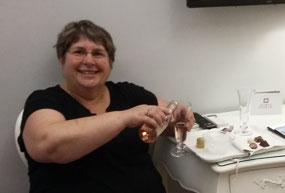
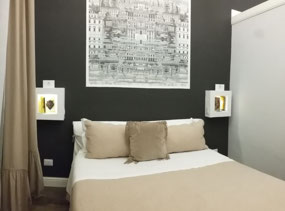
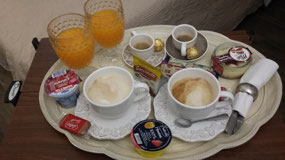
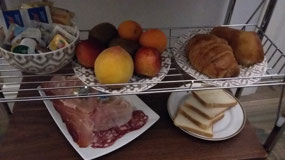
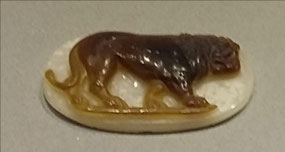
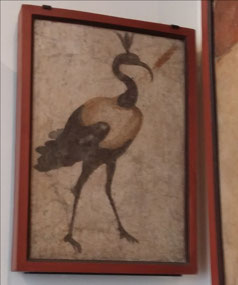
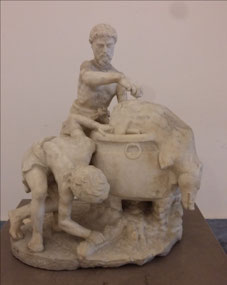









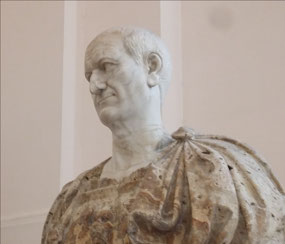
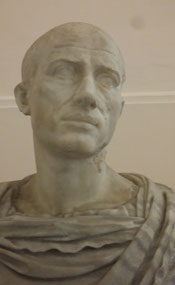
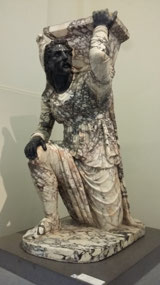
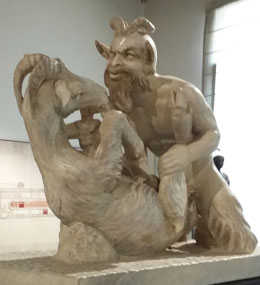
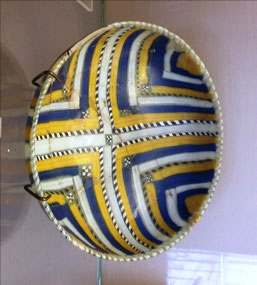
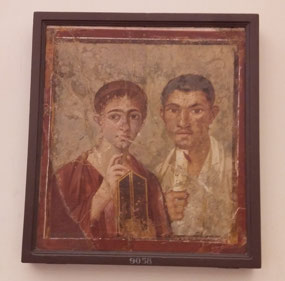
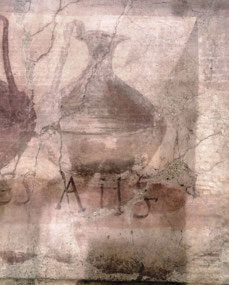

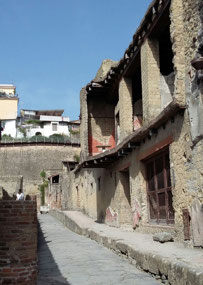
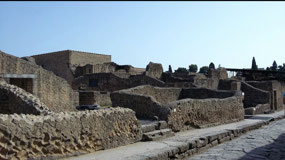
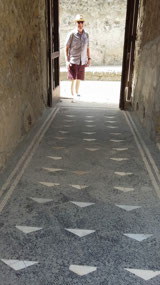
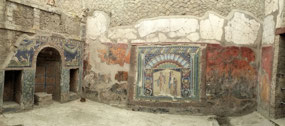
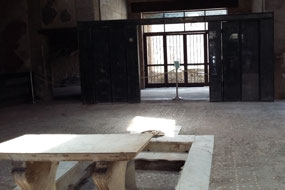
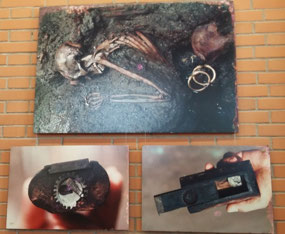
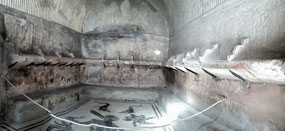
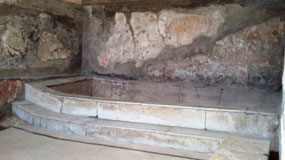
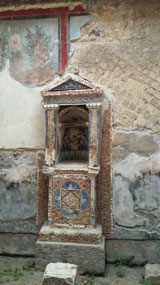
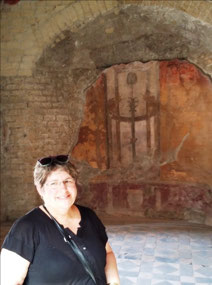
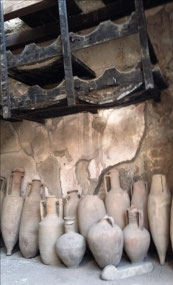
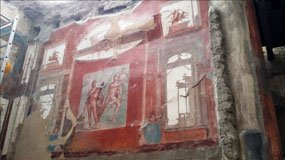
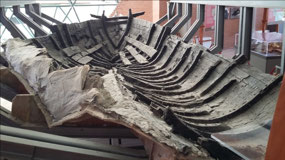

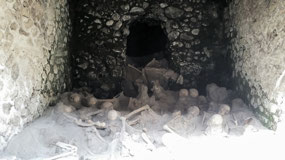
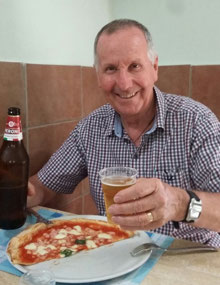
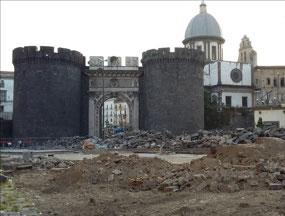
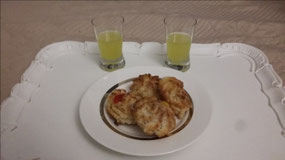
2025-05-23